In a marketplace teeming with millions of products, the challenge lies not just in setting up shop but in ensuring your products are discovered by the right audience. This is where Amazon PPC (Pay-Per-Click) emerges as a potent weapon in the marketing arsenal of every savvy Amazon seller.
Imagine having the ability to place your products directly in front of potential customers actively searching for items similar to yours. Amazon PPC offers precisely that – a strategic advertising platform that allows you to bid for prime visibility, elevating your products to the forefront of relevant search results.
In this blog post, we will delve into the intricacies of leveraging PPC to not only boost your product visibility but to strategically scale your business to new heights. We will uncover actionable Amazon PPC tips and insights gathered from real-life experiences and those of other successful sellers.
We’ll start with the basics of PPC and gradually deep dive into more advanced strategies, ensuring that whether you’re just starting out or looking to refine your tactics, there’s something here for you. The goal is to help you understand how to use Amazon ads effectively, so you can see tangible improvements in your sales.
Let’s dive in.
What is Amazon PPC?
Amazon PPC is an online advertising method where you bid in a keyword auction for prominent placements. If you “win” the auction, your ad will appear when a customer searches for your keywords. You only pay when a customer clicks on the ad, hence the name pay-per-click (PPC). But how does this advertising method help you stand out from the crowd and win loyal customers?
Gain Visibility with These 3 PPC Ad Types
- Sponsored Products (SP) – With SP, you can promote individual product listings on Amazon’s search results and competitor listings. This ad format gives you more organic ranking and increases your sales.

- Sponsored Brands (SB) – These ads feature your brand’s logo, multiple products, or specific headlines. Ads appear on the relevant search results and help you to increase your brand awareness and establishment on the market.

- Sponsored Display Ads (DSP) is a pay-for-impression self-service display advertising. It targets audiences and competitor listings. DSP grows your brand awareness by following buyers across the buying journey, on and off Amazon. You can recognize them at the top, middle, and bottom of your Product Detail Page (PDP).
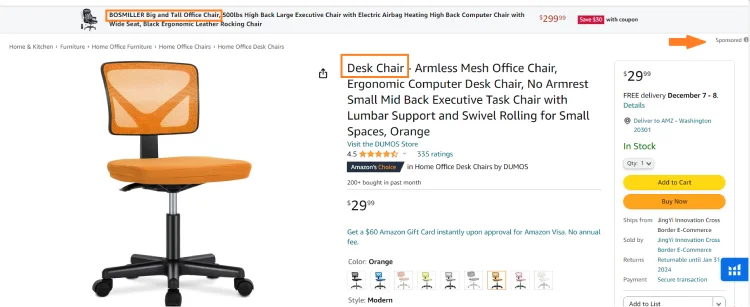
Now that you know what PPC on Amazon is, it is time to dive deeper into PPC optimization, 4 different ways to optimize your PPC campaigns and how they might benefit your business.
Driving Results: The Role of PPC Optimization in Amazon Advertising
Amazon PPC optimization plays a pivotal role in the success of your online advertising campaigns for various reasons.
Firstly, it ensures cost efficiency by maximizing the return on investment (ROI) and reducing wasted ad spend. By enhancing ad relevance through optimized targeting and compelling ad copy, campaigns achieve higher click-through rates (CTR), reaching the right audience and increasing the likelihood of conversions.
Optimization also positively impacts product rankings, leading to higher ad positions on search engine results pages (SERPs) and improved visibility. A crucial aspect is the enhancement of Listing Quality Score, which, when high, can result in lower costs per click. Adapting to market changes and staying competitive is facilitated by regular optimization, allowing sellers to adjust to dynamic trends and shifts in user behavior.
Moreover, PPC optimization involves refining landing pages and content to maximize the conversion rate, turning clicks into tangible outcomes. It fosters a data-driven approach, utilizing performance metrics for continuous improvement and informed decision-making. Additionally, it enables sellers to adapt to algorithm changes in search engines, aligning campaigns with the latest best practices and requirements.
In essence, Amazon PPC optimization is a strategic and ongoing process that goes beyond cost reduction, focusing on refining advertising efforts for long-term success on Amazon.
Now, turning to the second significant question: where is the optimal starting point?
4 Levels of PPC Optimization
These optimization systems mostly apply to Sponsored Products. Every optimization level is scalable in its own right. It is possible to build on these structures and add more keyword sets. The examples below are described for 1 set of keywords.
However, this does not mean you can only target 1 set of keywords in 1 structure. You can also use these structures to target Amazon Standard Identification Numbers (ASINs) as well. Each optimization level can consist of hundreds or thousands of campaigns.
Amazon allows you to optimize a few things at the campaign level:
- Budgets,
- Placements, and
- Bidding strategies.
At the ad group level, you can optimize
- Negative targeting,
- Default ad group bidding, and
- Analyze ad group-level search term data.
Now, let’s explore some strategies to enhance your PPC performance, igniting inspiration and providing a starting point for optimization initiatives.
First Level of PPC Optimization
This level may be the simplest but it’s also the most inefficient Amazon PPC strategy. It consists of only 1 ad campaign, with only 1 ad group. This particular ad group has 1 set of keywords with 3 different match types: exact, phrase, and broad. This means that if you want to target 25 keywords, you will need to add 75 keyword targets within the ad group.
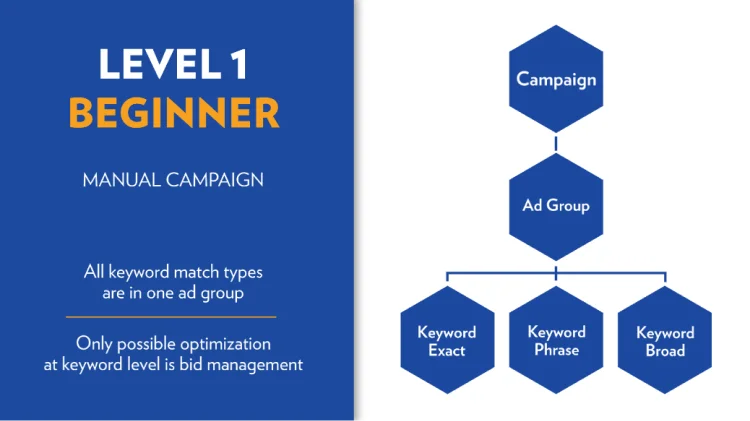
Everything is mixed in one place. That’s why if you want to optimize ad placements (top of SERP, Product Page, or rest of SERP), you’ll want to optimize placements for everything. However, you can’t optimize negative targeting properly because the keywords (KWs) in all three match types are targeting each other. Therefore, your Amazon PPC data at this level might look like a mess.
Second Level of PPC Optimization
This advertising level provides you with 1 campaign, with an ad group for each match type – for the exact, phrase, and broad KWs (3 ad groups in total). It helps you understand the performance of every match type better and optimize general bids more easily.
You can also negate the keywords properly because the different match types are separated. Thus, broad and phrase campaigns would not target the exact match KWs.
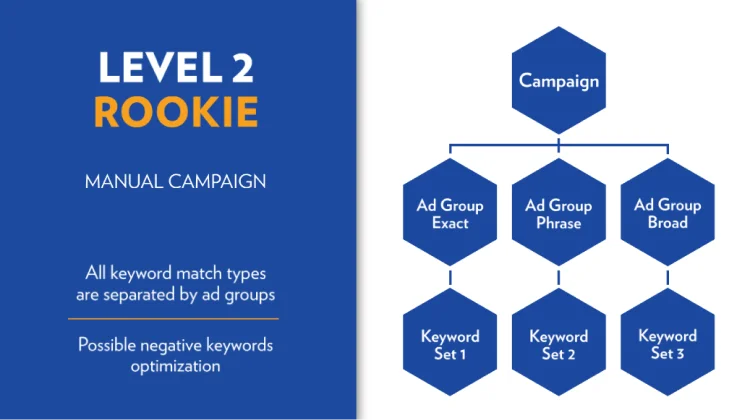
At the second level of optimization, there is an addition to the standard automatic campaigns. This part is rarely used by Amazon sellers themselves. It’s a more common action step for the agencies. Usually, the auto campaign contains 1 ad group, with 4 targeting groups “hidden” within. At the 3rd level within 1 campaign, you create 4 ad groups for each different targeting group:
- Close Match
- Lose Match
- Substitutes
- Compliments
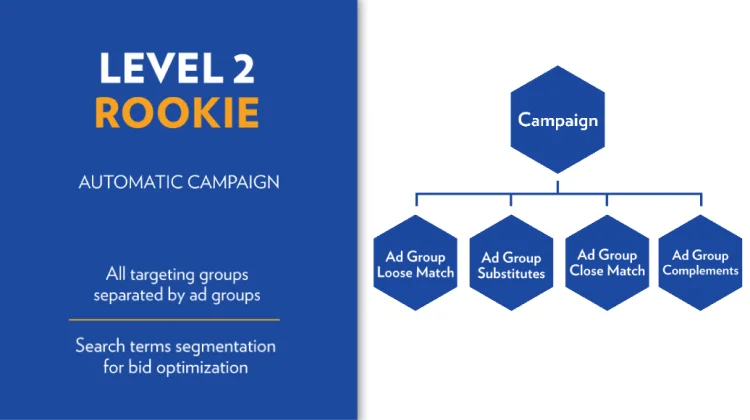
Thanks to the second level of optimization, you can see exact search terms for each targeting group. This helps you to optimize negative keywords in your campaigns, target group bids, and understand the data more easily.
Third Level of PPC Optimization
The third level of optimization allows you to build not 1 but 3 campaigns for the same keyword set.
Each campaign contains 1 ad group, and also 1 set of KW, which means there is an exact, broad, and phrase campaign. You can optimize placements, budgets, and bidding strategies for every keyword match type.
You can segment every match type and separate them into different campaigns. This is where you have a really good understanding of the performance of each match type and keyword set.
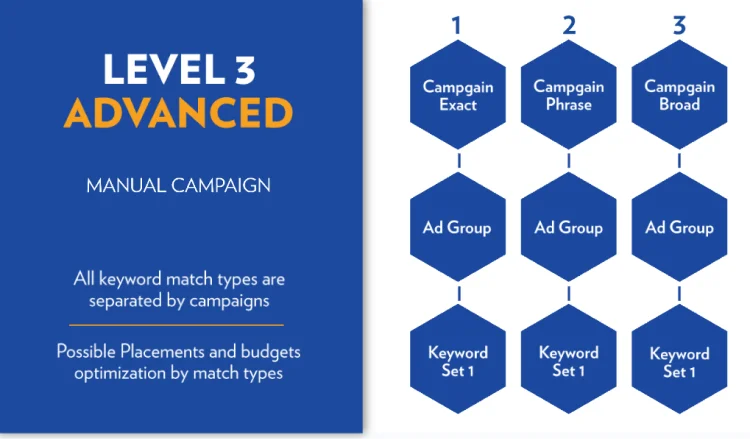
For this structure, you can run 4 automatic campaigns. Each auto campaign targets a different targeting group. This means you can optimize placements, budgets, and bidding strategies for each targeting group separately.
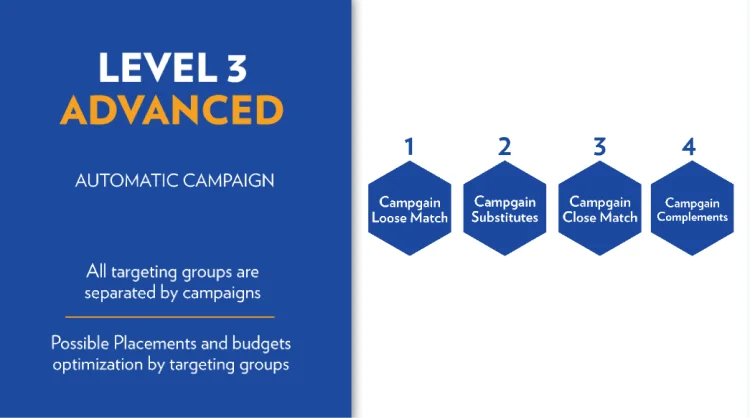
Fourth Level of PPC Optimization
The fourth level of optimization could be dangerous and beneficial, at the same time. It is achievable only with Amazon PPC management platforms like PPC Entourage. Usually, when you use the third type of optimization, you should optimize your campaigns once or twice a week. The fourth level gives you the chance to do it hourly.
This advertising structure consists of 1 campaign with 1 ad group and 1 target (keyword or ASIN) per campaign. Amazon gives you the ability to optimize every single target to its absolute maximum.
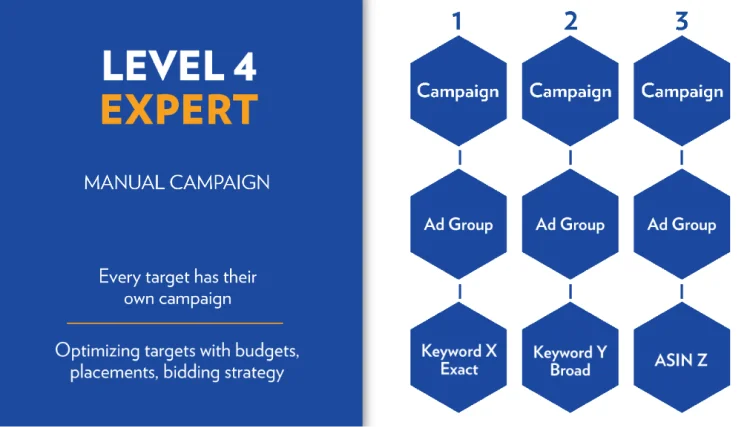
It’s possible to optimize placements, budgets, and bidding strategies for each target. This also allows you to see the exact Top-of-search Impression Share (ToS IS) for every targeted keyword or ASIN. Thanks to ToS IS data you know if you should continue pushing the target or pull it back.
As we mentioned above, nearly 10 million sellers will use Amazon in 2023. If you don’t manage your PPC campaigns properly, it can cost you a lot of money. In the following lines, you will find 5 tips for your PPC journey you can integrate immediately.
5 PPC Tips for Beginners
1. Craft Meaningful PPC Campaign Names
Strategically naming your campaigns doesn’t just make it easier for you to find them, but it will help you a lot when filtering or reading your data.
Use a simple naming convention like this [SKU| “Keyword/keyword family” | Initials| Match Type]. SKU stands for your product’s Stock Keeping Unit. KR stands for KW research. Date is self-explanatory. IN is the initials of the person who made the campaign. And then MT for the match type.
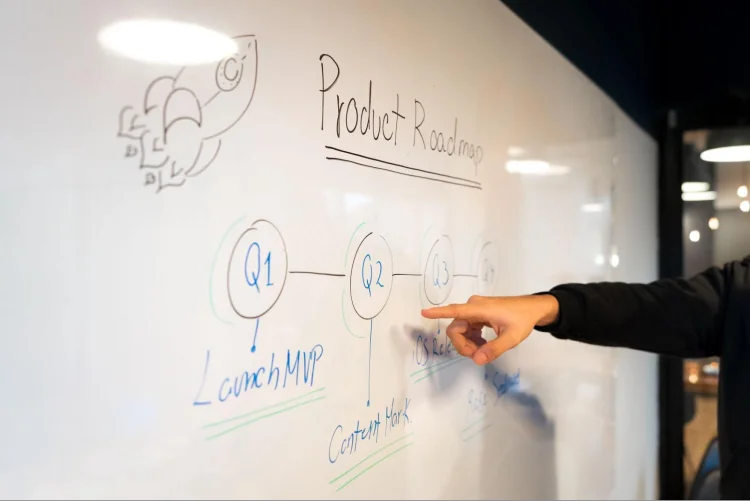
Of course, every Amazon business is different. You can form your own naming convention as your business grows but this information in your campaign names will ease your work significantly.
2. Segment to Scale
Once you’re done naming your campaigns properly, it’s time to launch them. No doubt, there’s a lot to choose from and it’s daunting to even understand what each specific campaign is for.
If you create your campaigns specific to a certain SKU or a product category, in other words: segment, Amazon will be able to index your listing more easily. Combining that with a great naming structure for your campaigns, you’ll easily find potential keywords once you start harvesting from your search term reports.
When you put all your products in one campaign, it’ll be extremely hard for you to read the data in your reports.
3. If on Budget, Slow and Steady Wins the Race
Competing head-on with the best of the best in your market is difficult and oftentimes very costly. If you’re facing budget constraints, consider starting from the bottom and work your way up to the top.
There are lots of ways you can do this, one of which is to target long-tail keywords. These keywords usually have cheaper cost-per-clicks (CPC), and for someone starting, that’s very helpful.
After building momentum or navigating through a period of high ACOS (Advertising Cost of Sale) and significant spending, it becomes imperative to shift your focus towards optimizing for profitability. Consider lowering bids on less profitable ASINs or search terms, reducing bids by ad placement, and removing irrelevant keywords.
4. Pay Attention to Negative Targeting
You’re not limited to just increasing bids and budgets when scaling your campaigns. Sometimes simply inserting a keyword or ASIN for negative targeting can boost your campaigns.
When doing your weekly optimizations, take a look at keywords or ASINs that have been bleeding your campaigns. Double-check that targeting if that’s relevant and use your intuition if it’s worth activating that keyword.
If that targeting has been getting a lot of clicks with 0 sales, it might be okay to lower the bid. If it happens for over a month, it might be a good idea to completely pause that targeting and have it as negative targeting. It will help you a lot with minimizing the ACoS of your campaigns in the future.
5. Do Keyword Research and Optimizations Regularly
How often should you check your campaigns? Should you add more keywords? Should you lower the bids now since it spent a dollar?
Doing additional KW research at least once a month is a good start. That includes harvesting from your search term reports, looking at Sponsored Products suggested, or through your KW research tools.

However, campaign optimizations should be done at least weekly. Check for:
- KWs that aren’t getting sales but are getting over 15 clicks
- KWs that are getting sales but have a very high ACoS.
- KWs that are performing really well, and think about increasing their bids once in a while if your TOS IS is low.
- And lastly, check if you need to make adjustments to your campaign budgets.
When your campaigns are set up well and your brand becomes more visible, and recognizable, your sales will increase. Just be careful not to drive your business into a stockout when running aggressive ad campaigns that could potentially create more demand than expected. It’s good practice to always keep your marketing and inventory teams looped in on your PPC campaigns to make sure there’s enough inventory to meet your forecasted demand.
To ensure smooth collaboration between the two teams, it’s essential to create crucial communication links. One effective approach is leveraging SoStocked’s inventory reporting tools.
For instance, you can employ these tools to keep a close eye on your store’s inventory status. Through such tools, the inventory manager has the capability to furnish the marketing manager with a comprehensive stockout risk report, highlighting products on the verge of running out of stock. Armed with this information, the marketing manager can promptly implement any necessary PPC campaign adjustments to avert potential stockouts.
Key Amazon PPC Takeaways and Next Steps
Amazon PPC effectively delivers targeted customers to your listings, increasing conversion rates, and enhancing your brand’s visibility. As we’ve explored in this article, utilizing Amazon PPC can be a game-changer for your business. Let’s outline some steps you can take moving forward:
- Review Your Current PPC Strategies: Take a look at your existing campaigns and see how they align with the strategies and tips discussed.
- Implement Segmentation: If you haven’t already, start segmenting your campaigns for better targeting and results.
- Focus on Long-Tail Keywords: Begin incorporating long-tail keywords into your campaigns for more cost-effective advertising.
- Schedule Regular Optimizations: Set a regular schedule for reviewing and optimizing your campaigns based on performance data.
- Keep Learning and Adapting: The world of Amazon PPC is always evolving, so stay informed about the latest trends and best practices.
Remember, success on Amazon’s marketplace is a marathon, not a sprint. By consistently applying these strategies and staying adaptable, you’re setting your business up for sustained growth and success.
If you want to know more about how to grow your business into a successful leader in your Amazon niche, you can say hi on LinkedIn, Facebook, or our website and we will be happy to help!




